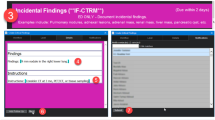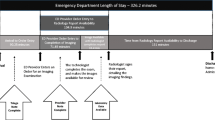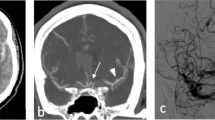Abstract
Purpose
Computer-aided detection (CAD) established its role in medical imaging as second reader aimed to boost the diagnostic accuracy of human interpreter. As the diagnostic performance of CAD systems improves and more imaging modalities are covered, CAD steps forward to fill new, more demanding positions in medical practice. In this paper, we investigate how the introduction of CAD for emergency diagnostic imaging shifts the use case paradigm from second reader to initial interpreter and triage tool.
Methods
We start from extracting common characteristics of exiting CAD systems and compare them to those for emergency diagnostic imaging modalities. Based on the deduced requirements, we define a new class of CAD systems—Computer-aided simple triage (CAST) and explore its properties, use case scenarios and clinical benefits. We also discuss the differences between the CAST, CAD, and automated computer diagnosis.
Results
A CAST system should serve as a simple triage tool performing a fully automatic analysis and providing initial classification at “per study” level. Positive studies are then immediately analyzed by expert reader, thus reducing delay for patients with critical conditions, while negative studies can be initially dealt with by less experienced staff. Automatic image quality and study complexity assessment can serve as reading prioritization key. CAST system should exhibit sufficiently high specificity, while not compromising the high sensitivity per study.
Conclusions
CAST systems have a potential to become an “enabling technology” allowing introduction of advanced imaging techniques into the emergency workflow protocols by addressing the reader unavailability and reading prioritization problems.
Similar content being viewed by others
References
Doi K (2007) Computer-aided diagnosis in medical imaging: historical review, current status and future potential. Comput Med Imaging Graph 31(4–5): 198–211
Karacan Ö et al (2002) Chest radiography and the solitary pulmonary nodule: inter-observer variability, and reliability for detecting nodules and calcification. J Radiol. http://www.jradiology.com/arts/45.pdf
Bird RE, Wallace TW, Yankaskas BC (1992) Analysis of cancers missed at screening mammography. Radiology 184: 613–617
Carney PA et al (2003) Individual and combined effects of age, breast density, and hormone replacement therapy use on the accuracy of screening mammography. Ann Intern Med 138: 168–175
Houssami N et al (2003) Sydney breast imaging accuracy study: comparative sensitivity and specificity of mammography and sonography in young women with symptoms. Am J Roentgenol 180(4): 935–940
Pisano ED et al (2005) Diagnostic performance of digital versus film mammography for breast-cancer screening. New Engl J Med 353: 1773–1783
Pickhardt PJ et al (2003) Computed tomographic virtual colonoscopy to screen for colorectal neoplasia in asymptomatic adults. New Engl J Med 349: 2191–2200
Carrascosa P et al (2006) Multidetector CT colonoscopy: evaluation of the perspective-filet view virtual colon dissection technique for the detection of elevated lesions. Abdom Imaging 32(5): 582–588
Hudyma E, Terlikowski G (2008) Computer-aided detection of early strokes and its evaluation on the base of ct images. In: International multiconference on computer science and information technology, IMCSIT 2008, pp 251–254
Chawla M et al (2009) A method for automatic detection and classification of stroke from brain CT images. In: Proceedings of the IEEE engineering in medicine and biology society (EMBC’ 09) Minnesota, USA, 2009, pp 3581–3584
Schoepf UJ et al (2007) Pulmonary embolism: computer-aided detection at multidetector row spiral computed tomography. J Thorac Imaging 22(4): 319–323
Lee N, Tek H, Laine AF (2008) True–false Lumen segmentation of aortic dissection using multi-scale wavelet analysis and generative–discriminative model matching. Proc SPIE Med Imaging 6915(2):69152V.1–69152V.11
Kovacs T et al (2006) Automatic segmentation of the aortic dissection membrane from 3D CTA images. Lect Notes Comput Sci 4091: 317–324
Arnoldi E et al (2010) Automated computer-aided stenosis detection at coronary CT angiography: initial experience. Eur Radiol 20(5): 1160–1167
Kundel HL, Nodine CF, Carmody D (1978) Visual scanning, pattern recognition and decision-making in pulmonary nodule detection. Invest Radiol 13: 175–181
Stein PD et al (2006) Multidetector computed tomography for acute pulmonary embolism. New Engl J Med 354(22): 2317–2327
Jones SE, Wittram C (2005) The indeterminate CT pulmonary angiogram: imaging characteristics and patient clinical outcome. Radiology 237: 329–337
Donnelley M, Knowles G, Hearn T (2008) A CAD system for long-bone segmentation and fracture detection. In: Proceedings of the 3rd international conference on image and signal processing, Cherbourg-Octeville, France, pp 153–162
Halpern E, Halpern D (2011) Diagnosis of coronary stenosis with CT angiography: comparison of automated computer diagnosis with expert readings. Acad Radiol 18(3): 324–333
Author information
Authors and Affiliations
Corresponding author
Rights and permissions
About this article
Cite this article
Goldenberg, R., Peled, N. Computer-aided simple triage. Int J CARS 6, 705–711 (2011). https://doi.org/10.1007/s11548-011-0552-x
Received:
Accepted:
Published:
Issue Date:
DOI: https://doi.org/10.1007/s11548-011-0552-x




